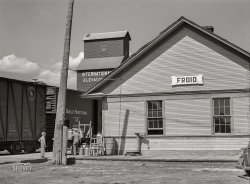
MAY CONTAIN NUTS

Search Shorpy
SHORPY ART

Framed or unframed, desk size to sofa size, printed by us in Arizona and Alabama since 2007. Explore now.
Join and Share
Ad-Free Shorpy
Shorpy is funded by you. Patreon contributors get an ad-free experience.
Learn more.

Recent comments
- Baldwin 62303
- Baldwin VO-1000
- Cold
- No expense spared
- Tough Guys
- Lost in Toyland
- And without gloves
- If I were a blindfolded time traveler
- Smoke Consumer Also Cooks
- Oh that stove!
- Possibly still there?
- What?!?
- $100 Reward
- Freeze Frame
- Texas Flyer wanted
- Just a Year Too Soon
- WWII -- Replacing men with women at the railroad crossing.
- Yes, Icing
- You kids drive me nuts!
- NOT An Easy Job
- I wonder
- Just add window boxes
- Icing Platform?
- Indiana Harbor Belt abides
- Freezing haze
- Corrections (for those who care)
- C&NW at Nelson
- Fallen Flags
- A dangerous job made worse
- Water Stop
Member Photos
The Shorpy
Print Emporium
Print Emporium
Search Shorpy
Search results -- 30 results per page
- Double Duty: 1942
- April 1942. "Wisdom, Beaverhead County, Montana. Accommodations at the Wisdom Hotel." Acetate negative by John Vachon ... Posted by Dave - 10/26/2021 - 1:02pm -
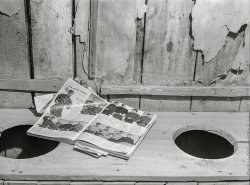
- Superior Street: 1909
- ... laws eventually adopted in Washington, Oregon, Idaho, Montana, Arizona, New Mexico, Texas, Kansas, Louisiana, Missouri, and ... Posted by Dave - 08/13/2012 - 6:42pm -
![Superior Street: 1909 Duluth, Minnesota, circa 1909. "Superior Street." The newsboy's headline: JAP RIOT CRISIS. 8x10 inch glass negative, Detroit Publishing Co. View full size.
Maybe he stepped on a hatTwo things on the right immediately caught my attention:
1. There is a bald man walking down the street; he appears to be the only man in downtown Duluth not wearing a hat. He must have met with some devastating hat disaster. That shiny pate REALLY sticks out!
2. The man in front of Fitger's Beer who is looking down at his feet or something on the ground. I'm pretty sure he was saying or thinking: "Aw man, what did I just step in?"
Coming or going?This guy doesn't appear to be a window washer!
The Lyceum TheatreSaid to be Duluth’s first “fire-proof” theatre. It was built for live theatre in 1892, but in 1921 it was converted to showing movies. Demolished in 1963.
What did the Japanese do?To get that headline.
Fitger's beerhttp://www.fitgers.com/subpage.php?page=History
Hawaii RiotsThe newsboy's headline concerns an incident during a labor strike by 10,000 Japanese sugar plantation workers on the island of Oahu in Hawaii. The wire service "riot" story was datelined "Honolulu - June 9" and ran in the New York Times on June 10, 1909. The wider story about this strike and its developments ran in many mainland newspapers throughout June and July, and concerned the efforts of Japanese sugar workers in Hawaii to achieve a wage increase from $18 per month to $22 per month. Much of the press coverage seems to have focused on "yellow peril" conspiracy fears, but a more nuanced report, "Who Will Develop the Wealth of Hawaii?" ran in the Times on June 27, detailing new efforts by white plantation owners to attract Filipino, Portuguese and Puerto Rican immigrants to replace the "restless and ambitious" Japanese.
News of the day?Can we get a close-up of the newsie to read his tantalizing two-word headline? Any guesses?
[Anyone read the caption under the photo? - Dave]
Spot the signIt looks hot and dusty -- perfect venue for a Coca-Cola advertisement!
Jap RiotThe headlines referred to riots in California due to a spate of new laws affecting the Japanese population. Below is an outline of the years before and after the riot. It clearly paints a picture for what happened during WWII.
1906
San Francisco School Board orders segregation of 93 Japanese American students.
1907
On orders from President Theodore Roosevelt, S.F. School Board rescinds segregation order, but strong feelings against Japanese persist. Anti-Japanese riots break out in San Francisco in May, again in October, much to the embarrassment of U.S. government.
Congress passes immigration bill forbidding Japanese laborers from entering the U.S. via Hawaii, Mexico, or Canada.
1908
The Asiatic Exclusion League reports 231 organizations affiliated now, 195 of them labor unions. U.S. Secretary of State Elihu Root and Foreign Minister Hayashi of Japan formalize the Gentlemen's Agreement whereby Japan agrees not to issue visas to laborers wanting to emigrate to the U.S.
1909
Anti-Japanese riots in Berkeley. U.S. leaders alarmed at tone and intensity of anti-Japanese legislation introduced in California legislature.
1910
Twenty-seven anti-Japanese proposals intro-duced in the California legislature. White House urges Governor Hiram Johnson to seek moderation.
1913
Alien Land Law (Webb-Haney Act) passed, denying "all aliens ineligible for citizen-ship" (which includes all Asians except Filipinos, who are "subjects" of U.S.) the right to own land in California. Leasing land Iimited to 3 years. Similar laws eventually adopted in Washington, Oregon, Idaho, Montana, Arizona, New Mexico, Texas, Kansas, Louisiana, Missouri, and Minnesota.
1915
The Hearst newspapers, historically hostile to Japanese, intensifies its "Yellow Peril" campaign with sensational headlines and editorials, fueling anti-Japanese feelings.
Something's missingCan't find the United Cigar Store!
Another Japanese connectionIn addition to the "JAP RIOTS" headline, a sign on the Great Northern Railway office announces steamship sailings from Seattle to Yokohoma and Kobe.
On a completely separate note, while street crowds in most vintage cityscapes tend to be predominately male, this one is the most extreme, with almost no women visible. It looks almost like a modern street scene in the Middle East.
I'll passon the Hot Beef Tea! Although 5 cents is a good price for lunch.
Count 'emThere are THREE trolleys running up this street. If I missed one, no problem! I could just wait a minute and hop on the next one!
Let's not forgetThe best 5 cent lunch in the city. Was it the Hot Beef Tea that they were advertising?
Hot Beef TeaThat's what it looks like the sign says. Or maybe it's Hot Beet Tea, which sounds even worse.
How to make it:http://www.thestrugglingcook.com/beef-tea.html
Beef teaBeef tea is nothing more than what we now know as beef broth, beef bouillon, or beef consomme. One of my unfailing go-to beverages when I am feeling puny, or (unfortunately) on a liquid-only diet. Why it was a big deal in 1909 I have no idea. I am more concerned about the dude in the window, whether he is coming or going. My theory is that the husband came home unexpectedly.
(The Gallery, DPC, Duluth, Streetcars)](https://www.shorpy.com/files/images/SHORPY_4a23201a.thumbnail.jpg)
- Ghost Cafe: 1941
- ... on main street of ghost town. Judith Basin County, Montana." The Home Cafe / Kandy Kitchen / Eat Shop. Also, Rooms. Medium format ... He was legend for his philanthropic work in Helena, Montana, as well as for high-yield bakeries in that state (one of which ... about her skills.
Geyser The ghost town is Geyser, Montana, which still exists. Ms. Wolcott took other pictures of this ghost ... Posted by Dave - 10/11/2019 - 5:46pm -
![Ghost Cafe: 1941 September 1941. "Building on main street of ghost town. Judith Basin County, Montana." The Home Cafe / Kandy Kitchen / Eat Shop. Also, Rooms. Medium format negative by Marion Post Wolcott for the Farm Security Administration. View full size.
Put the hammer downEddy's Pan Dandy Bread was the creation of J.E. "Eddy" O'Connell (1886-1972), who due to his business acumen combined with a gentle demeanor, earned a reputation as a "velvet hammer" and a "cream puff filled with concrete." He was legend for his philanthropic work in Helena, Montana, as well as for high-yield bakeries in that state (one of which operated beneath a brothel), and from Utah and Washington to the Dakotas. On his and his wife's shared tombstone in Resurrection Cemetery in Helena is etched a loaf of Eddy's bread.
Was also the post officeOr so say the washed out words above the East Shop Cafe.
[Eat Shop. - Dave]
[ :) ... And me on a full, non-SloppyType keyboard I've used for almost 30 years. ]
Fading AwayI can see the faded letters for POST OFFICE, but this photo would have been a perfect place for a similar ghostly image of the SHORPY logo. I wonder what the original colour of the building was?
So preciseI'm always delighted viewing Ms. Wolcott's photos. The subjects are interesting and her skill with the camera, in a technological way, is superb. Here, the edges of the photo and the corner posts of the cafe look as if a draftsman laid them out. I didn't take a micrometer to prove parallel, but I wouldn't be surprised learn that she'd achieved it. Great "pichertaker" she was.
[Some of the credit goes to Photoshop. - Dave]
Please, leave my other fantasies alone, I liked being the way I was about her skills.
GeyserThe ghost town is Geyser, Montana, which still exists. Ms. Wolcott took other pictures of this ghost town, including a few of the former First National Bank. That building survives, which is how ID'd the town after making an educated guess it was the place.
(The Gallery, Eateries & Bars, Frontier Life, M.P. Wolcott)](https://www.shorpy.com/files/images/SHORPY-8c15661a.thumbnail.jpg)
- Crate & Barrel: 1936
- ... these pictures of the migration from North Dakota and Montana to the Northwest. I wish my parents were still alive to see these ... travelers.
My parents were the children of farmers in Montana. My mother's family lost their farm when the bank that held the ... Posted by Dave - 08/06/2012 - 4:47am -
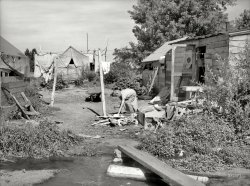
- Salvage for Victory: 1942
- ... for Victory' campaign -- scrap and salvage depot in Butte, Montana." Kodachrome transparency by Russell Lee for the Office of War ... miles away, a bit south of the present-day intersection of Montana Street and I-15.
Other images from Russell Lee's Butte scrapyard ... Posted by Dave - 11/17/2019 - 5:12pm -
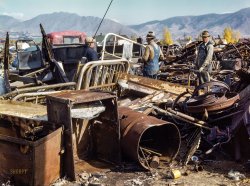
- Unangst Block: 1942
- August 1942. "Street in Dillon, Montana, trading center for a prosperous cattle and sheep country." Evidently a ... Posted by Dave - 01/05/2013 - 4:56pm -
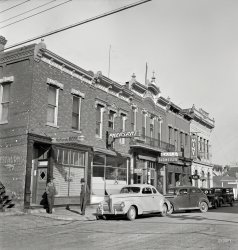
- Dillon: 1942
- August 1942. "Street corner, Dillon, Montana." Originally posted in 2007; today we published this black-and-white ... Posted by Dave - 12/13/2012 - 10:07am -
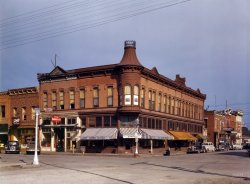
- Dead Letter Office: 1922
- ... great uncle used to tell. When he moved his family from Montana to Arizona by car in the 1930's (?) he was concerned that his car tires ... saved enough money to purchase a new tire, he would MAIL a Montana tire back to his dad - one at a time! It probably took several months ... Posted by Dave - 08/29/2012 - 8:46pm -
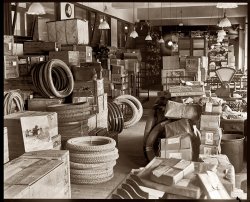
- Dry Goods: 1936
- ... have said, though.
Nothing left of Grassy Butte Montana except a radio tower.
Across the street from Robert Evans, I guess ... speed Internet service.
Nothing left? Maybe not in Montana, but in Grassy Butte, North Dakota...
View Larger Map ... Posted by Dave - 09/13/2012 - 10:28am -
![Dry Goods: 1936 July 1936. "J. Huffman of Grassy Butte, North Dakota, has been forced to close his general store on account of the drought." Medium-format nitrate negative by Arthur Rothstein for the Resettlement Administration. View full size.
Faded lettersI can't help but think that the "O" and the "G" on the building were the first letters of something; but what? The word "Gen" (as in "General") has almost completely faded away from "Gen M'dse", so it's tempting to think that other letters--perhaps in the same less-than-weatherproof paint--once followed the "O" and the "G". I can't imagine what it might have said, though.
Nothing leftof Grassy Butte Montana except a radio tower.
Across the street from Robert Evans, I guessThree or more general stores in the same tiny town. During the Depression, no less. Maybe he was across the road from Robert Evans, with the bare light bulb dangling over the gas pump.
I love the sign painter's signature. You can still see this kind of work in Mexico, and maybe a few towns north of the border. In the unlikely event that these clapboards survived into the late '80s, I'd be amazed if they didn't end up on the wall of a frontage road chain restaurant (I don't know which one, as I try to avoid them). Next door, no doubt, to the Wal-Mart, which eventually finished off those colorful family-owned stores that survived the Depression.
OI don't think it's an O at all. If you look at the bottom, it looks like the top half of an 8. But even with that, it remains a mystery.
But the picture's of the ND Grassy ButteGrassy Butte, North Dakota is still there. It has a bar (the Long X Saloon), a community center, a post office, a Standard service station (Beicegel Station, probably also a convenience store), a fairly large church, and what look like several other businesses, and even some trees. Pretty much all the necessities of life, except maybe high speed Internet service.
Nothing left?Maybe not in Montana, but in Grassy Butte, North Dakota...
View Larger Map
Signed workLooks like Speedy signed and dated his work for the J. Huffman Merchandise sign -- 8/29/29 I think. Wonder what the O and G are for?
[Looks like 8/29/27 for the sign and 9/17/32 for the windows. - tterrace]
O & G?I fiddled with this wonderful image in Photoshop and I think I see tracess of faded letters, in a different color, that show the sign to have originally been Oil & Gas.
I won't swear to this, and I wish I could see a pump to back up my theory.
--Jim
Super BallPeeking over the roof line is a Super Ball Radio Antenna.
Dry Goods: 1936John Paul Huffman was born in 1878 and died in 1965. Four years after this photo was taken, Mr. Huffman no longer owned the store. According to the 1940 census, he lived in the neighboring town of Rhoades and worked as a clerk in a retail store. I have located two of his granddaughters, and I plan to call them soon.
(The Gallery, Arthur Rothstein, Great Depression, Stores & Markets)](https://www.shorpy.com/files/images/SHORPY_8b28080a.thumbnail.jpg)
- Greener Pastures: 1936
- ... family moving to Idaho at port of entry near Miles City, Montana." Medium-format nitrate negative by Arthur Rothstein for the ... What qualifies as a "port of entry" in the middle of Montana? (Side note, I spent the evening in Miles City during a road trip last ... Posted by Dave - 07/29/2012 - 12:05am -
![Greener Pastures: 1936 July 1936. "Drought refugees. North Dakota farm family moving to Idaho at port of entry near Miles City, Montana." Medium-format nitrate negative by Arthur Rothstein for the Resettlement Administration. View full size.
The spitting imageof Henry Fonda in Grapes of Wrath, or vice versa.
Maybe they're my neighbors nowI hope this family was able to make it in Idaho. They might have descendants living just north of me.
HeroesForget your present day interpretation of the the word, THESE were the true personification of the term.
NecessitiesA case of Hershey's chocolate, a case of Post Toasties and a copper laundry boiler. What else do you need?
Maxwell MysteryI'm trying to figure out the make of the car prior to it becoming a truck, based upon the M on the hubcap; several possibilities from the 1920s are Moon, Marmon, Marquette and Maxwell. In numbers, far more Maxwells were made than of the other choices. It surely never was a Mercedes or Minerva, and Mercury didn't begin production until later in the 1930s.
[It's a circa 1925 Maxwell touring car. - Dave]
Port of entry?What qualifies as a "port of entry" in the middle of Montana? (Side note, I spent the evening in Miles City during a road trip last year. It's the tenth-largest city in the state with a mere 8,400 people.)
1923 Maxwell TouringI believe that the car started as a 1923 Maxwell Touring Car. The running board apron with the raised border and the step plates along with the headlight shape lean toward a 1923. The 1924-25 Maxwell tourings had a different windshield mounts.
By June of 1925 Chrysler had ceased production of the Maxwell and had transformed this model into a Chrysler B series. Basically a rebadged Maxwell.
The little girlThe look on that girl with her arm up shading the sun from her face is haunting.
The vehicle and environment look so rough and unforgiving. I truly hope this family made it ok.
(The Gallery, Arthur Rothstein, Cars, Trucks, Buses, Dust Bowl, Kids)](https://www.shorpy.com/files/images/SHORPY_8b28075a.thumbnail.jpg)
- Texaco: 1925
- ... I recently found a service station off I15 outside Helena, Montana, that did that and more. They offered self and full service. Full ... Posted by Dave - 08/07/2012 - 10:13pm -
![Texaco: 1925 Washington, D.C., 1925. "Texas Company station, Rhode Island and New Jersey avenues." View full size. National Photo Company Collection glass negative.
Texaco 1925I grew up in the D.C. area. As near as I can determine, the address of this Texaco station would have likely been 420 Rhode Island Avenue NW. At that address presently, according to the Yellow Pages, is another gas station, the Rhode Island Avenue Service Center. I wish I could go take a look, but I live in Massachusetts.
Do I see ...... 29 cents a gallon? Oy.
[Regular is 19. - Dave]
Gas PricesThat nineteen cents a gallon was likely just as expensive to the consumer back then as four bucks a gallon is today. The main difference is the guy buying the gas wasn't putting two hundred miles a week on his car.
19 Cents a GallonPer www.measuringworth.com, 19 cents in 1925 would be the equivalent of $4.98 in 2007.
InflationAccording to the Bureau of Labor Statistics inflation calculator (http://data.bls.gov/cgi-bin/cpicalc.pl), 19 cents in 1925 is the equivalent of $2.33 in 2008 dollars. Not cheap, but not quite as much as $4 a gallon.
When it was really cheapI remember when we drove across the US in 1969 that regular price was around 20 cents, remembering that "regular" in those days was not the lowest grade at most stations. We had a card from one chain that allowed us to buy regular at the "economy" price. In some places we paid 17 cents or possibly less. The BLS says that gas should have cost 40 cents in 1969; between that and camping in National Forests once we got far enough west, you could have a pretty cheap trip.
TexacoThat map image looks correct - the building on the right side of the map image looks like the one in the background of the old photo, though it looks like they added on to the rear of the building. Cool.
Painted PricesBesides the price, what struck me as interesting is that the prices appear to be painted on the pumps. Did gas prices not change all that often back in the '20s?
CarsYou have to say also that not many people owned a car then. The real reason is people who owned a car then meant you were doing well.
[Not so. In 1925 there were around 18 million automobiles registered in the United States. The year before, Ford had built its 10 millionth Model T. - Dave]
So cool!I live at First and S. There are currently two gas stations at the corner of Rhode Island Ave and New Jersey Ave NW. I believe this site is on the SW corner, which would be across the street from the Hess station pictured above.
Spark PlugsChampion spark plugs at 49 cents must have been pretty expensive back in the day. I bet they didn't last like they do today either.
The big bright Texaco star"You can trust your car to the man who wears the star."
Back when they pumped your gas, cleaned your windows all around (without a squeegee) and checked under the hood looking for worn belts and hoses while pulling the dipstick.
I recently found a service station off I15 outside Helena, Montana, that did that and more. They offered self and full service. Full service cleaned both the outside and inside of all my windows. There were at least four people working on my car at the same time.
The guy who ran the operation was an ex-military type. His employees were super courteous. Needless to say the restroom was so clean, I could've eaten off the floor.
I was flabbergasted!
(The Gallery, D.C., Gas Stations, Natl Photo)](https://www.shorpy.com/files/images/27318u_1.thumbnail.jpg)
- Park Hotel: 1905
- ... of the century, Grain Belt could be had from Michigan to Montana. - Dave]
That hot, stuffy gable room If it's not a "box room" ... Posted by Dave - 08/20/2012 - 4:21pm -
![Park Hotel: 1905 Sault Sainte Marie, Michigan, circa 1905. "Park Hotel." An interesting cast of characters in less than parklike surroundings. Detroit Publishing. View full size.
VacancyThe Soo still has a lot of old buildings, but this one was torn down in 1972. In the early 1900s, most people came to the Soo via ship and occasionally rail, and most if not all hotels were down by the river. Today there are only a few still hanging on for the tourists, and most motels are franchises up on the business spur near the highway and fast food.
Grain Belt export?Seems a long way from home in Minneapolis for 1905.
[Minneapolis Brewing Company operated a regional network of brewhouses, bottling plants and storage depots. By the turn of the century, Grain Belt could be had from Michigan to Montana. - Dave]
That hot, stuffy gable roomIf it's not a "box room" (the name is self-explanatory), it might well be a room for servants, cooks, and/or staff. The rooms closest to the roof are always the least desirable, and thus relegated (even today) to the help. After all, the workers aren't supposed to be in their rooms very much anyway!
What I'm wondering about is the collection of courtly, retired, mustachioed gentlemen on the porch. In the winter, would they gather in a public parlor with a coal stove? They all look as if they could easily reminisce about the cold and muddy bivouacs they endured "tenting tonight on the old camp grounds" during the Civil War.
Gable RoomThese old buildings (of course it wasn't old then) always have what I call "fun" or "mysterious" rooms jutting up out of them that make me wish I knew what they were like inside. In this one it's is the gable room -- that's where I would want to stay if in fact it's a used room and not just a decorative add-on. There can't be much of an attic because the rest of the roof is flat.
Transfer? From what? To where?Now here's a picture full of questions. I see two very proper ladies in waiting standing next to one or two gentlemen who "moved." One shoe shine man. Three newsies and one non-newsie. Five gents on the porch. Three drivers and four and a half horses. What I'd like to know is what kind of "transfer" is indicated by the sign over the ladies and the printing on the sides of the coaches. I see rails in the street but no overhead wires. Maybe for horse drawn rail cars? (There is definitely horse evidence between the rails.) Or maybe it's a steam railroad? Have the ladies been brought to this point by one of the transfer coaches and now await a train? Looks like there are short stairs midway down the hotel's hallways where the building addition starts, as the windows don't match up. Add a "grain belt" sign, a mailbox, a fireplug, a decrepit bill on the "telly-pole," the electrified transfer sign, and you have a fascinating scenario. The only thing we don't see is the photographer. Who was he and why was he taking the picture?
[There is a big thick streetcar wire overhead. The sign says FREE EAGLE LIVERY TRANSFER (scroll up). The photo is one of many thousands made by Detroit Publishing Company for use as postcards and prints. - Dave]
Here It IsI like the sign across the middle of the street that helps you locate the Park Hotel. From the position of the sign, I'd presume that the majority of folks are heading there from the left side of the picture. Interesting.
Soo Memories, NOTFunny - I lived in the Soo from '67 to '70 and drank in a hole-in-the-wall bar right next to where Google says the Park Hotel was, but I have no recollection of it. Maybe I should have drunk less.
Then again, the Soo was pretty down at the heels back then and the hotel may have been just another derelict building.
The Eagle Suffers Little Birds to SingThe sign says EAGLE LIVERY TRANSFER. The wagons belong to the Eagle Transfer Company, who held a concession with Duluth, South Shore and Atlantic Railway.
It might not look parklike to us, but the camera was on the edge of a nicely landscaped park overlooking the locks. Plenty of shots exist on Library of Congress site.
Acme Inc.That phone pole looks like one of Wile E. Coyote's props, cocked to flatten the Road Runner. Of course that's not how things will turn out.
The hotelIt's down at the end of Lonely Street, or was that the Heartbreak?
Much in need of a First Class shoe shineEspecially with all the mud, etc., on that street. I shudder to think how shoes shined in a Second Class Manner would turn out!
Ghosts of years pastI like the ghostly shoe by the shoe shine sign, very apropos and there are two apparations beside the ladies. I think this should give us pause to slow down in life and watch for photographers so that we don't end up as a blur in the background in the future.
Back in '71I was stationed at nearby Kincheloe A.F.B. My buddies and I spent many an evening "painting the town", mosquitoes and snow permitting. I'd sure like to know exactly where this building was so I could search my memories. If it was near the locks and was indeed still standing in 1971 I might remember having seen it.
[The Park Hotel was at the southeast corner of Douglass Street (later Osborn Boulevard) and West Portage Avenue, according to this book. - Dave]
Transfer LineI'm not familiar with the situation in Sault Sainte Marie, but "transfer" lines almost always referred to omnibus services that ran between the railroad depot and local hotels. The far was usually 25 cents round trip, and typically a traveler was given a token or ticket to use for the return trip back to the railroad depot after his business was done in town.
(The Gallery, DPC)](https://www.shorpy.com/files/images/4a22789a.thumbnail.jpg)
- Beer Belle: 1939
- June 1939. "Dudes at bar. Birney, Montana." Medium format acetate negative by Arthur Rothstein for the Farm ... 4 p.m. (according to the clock on the shelf) since June in Montana can be pretty hot and we only go around once in life. Why wait until 5 ... Posted by Dave - 09/06/2018 - 3:10pm -
![Beer Belle: 1939 June 1939. "Dudes at bar. Birney, Montana." Medium format acetate negative by Arthur Rothstein for the Farm Security Administration. View full size.
Grabbing the gustoNot quite an upscale gin mill, but the lady appears to be relishing her thirst quencher and doesn't care that there is not even one bar stool on which to sit. Looks like the bar is hand-built, there is no shade over the naked light bulb and it is only 4 p.m. (according to the clock on the shelf) since June in Montana can be pretty hot and we only go around once in life. Why wait until 5 p.m. to start drinking and who needs "ambiance"? The bartender has a contagious, magnetic smile and is happy to have customers.
Top ShelfThere's no denying that all the liquor proffered was — indeed — top shelf.
Bell-Bell-LemonAnd right there, put in temptation's way next to the beer, is what appears to be a nickel slot machine--maybe a Daval?--with a small stash of cash ready to buy the next turn on the dials or the next beer, whichever seems the better idea.
Is "dude" gender specific?I guess not, but I still prefer using "dudette" when referring to a woman.
[Dudes are the guests at a dude ranch. - Dave]
Speaking of dudes.Here is my aunt with a friend at a "Dude Ranch" somewhere out west. It was kind of a thing to go out and get all cowboyed up and hang out at the ranch back in the day.
Not going to make the obvious jokeabout what appears to be a woman slugging back that beer, but of course "dude" meant something different in those days.
[Dudes are the guests at a dude ranch. - Dave]
Is that a slot machine?That appears to be some type of revenue generator on the bar. The bar itself reminds me of my late father's type of construction. In his words it was " not much for looks but hell for strong."
“Scrap” wood barInteresting how all the scraps used to create the bar are clear and knot-free.
Pick me, American!That Orange Crush cooler is just waiting for Frank or Mike or Danielle to drop in and start peeling off bills from a roll of fifties.
(The Gallery, Arthur Rothstein)](https://www.shorpy.com/files/images/SHORPY-8b17832a.thumbnail.jpg)
- First Clouds, then Sun: 1963
- "Going-to-the-Sun Hwy., Glacier Nat. Park, Montana. June 8, 1963." 35mm Kodachrome transparency. View full size. Today ... Posted by Dave - 09/18/2009 - 3:45am -
![First Clouds, then Sun: 1963 "Going-to-the-Sun Hwy., Glacier Nat. Park, Montana. June 8, 1963." 35mm Kodachrome transparency. View full size. Today we continue our selection of vacation slides found on eBay and in a thrift store out west (tip of the Shorpy cap to Tom Munoz). Above is the vacationing Great Falls family we met yesterday, in a picture taken the year after this one. Anyone ready for a sandwich?
WOWwhat else can you say, what a spot to stop for a picture!!
Global Warming in 1963It was said, within the past few years, that snow melting in summer months in Glacier Park was proof of global warming. This photo shows snow melting there 44 years ago. At the time, I believe, the alarmists were warning of global freezing.
[The snow always melts in the summer at Glacier (and this snow has been plowed; the road and the car are wet from rain). What people are worried about is the glaciers disappearing, not melting snow. - Dave]
Just west of the East TunnelThis is a turnout just west of the East Tunnel on Going-to-the-Sun Road. The Mountain looming behind is Going-to-the-Sun Mountain. The photo was taken here (Google Maps).
Awesome shotThanks for this pic Dave (and all the other pics too). Immediately reminds me of a hundred different looooonnnng car trips when I was a kid. Funny just how much perspectives (and responsibilities) change when you're sitting in the front instead.
BTW, those were the days when winding, mountainside roads were cool (before the advent of those pesky view-clipping safety rails)...
[Going-to-the-Sun looks pretty much the same today, with a low stone wall instead of guardrails along much of the road. - Dave]
I see HitchcockI tell you, these red stationwagon slides look astounding! I think the person who took these was also the cinematographer for North by Northwest.
"Shining" exampleThis road was seen during the opening credits of "The Shining."
Little Red ChevroletI believe that Chevy is a '62 or '63. We had a '61 Bel Air (tan) for 13 years. My sister and I rode in that old beast until I was a senior in high school (we bought it before I started school). They were great cars!
[This is a 1960 Chevrolet. - Dave]
Steep ShoulderI traveled this road in the late 1960's. As you say, the most there is is a low stone wall. The dropoff is waaaayy down there! I was astounded how those who worked there and traveled this road constantly tore around like they were driving on flat land. It was here that I came to the conclusion that I really did not like heights.
Running up that hill (in a car)This is a super photograph - it looks professional. The car is in the right place in the frame, the splash of red contrasts with the purply-blue backdrop, and he even managed to get the top of the mountain in shot. The only thing that throws it a bit is the people in the car. They're obviously just sitting there waiting for the man of the house to take his snapshot, and it comes across as artificial. They should have been outside the car, gazing at the mountains. I bet they said "no way" because it was freezing cold.
And it's sharp, which must have been tricky in such dull conditions. Judging by Wikipedia's timeline of Kodachrome film this was probably ISO 25, although a 64-speed version had been introduced a year before (perhaps the man was trying some out). Perhaps he had a tripod.
I wonder what his family thought of him, stopping the car and hopping out in the freezing weather to take a picture (of the car, and not of them). They must have thought he was bonkers. Or that he was a typical man, fixated on cars and scenery rather than people. But then again this is a photograph he threw away; perhaps he kept the ones he took of his family.
(The Gallery, Cars, Trucks, Buses, Kodachromes 1, Travel & Vacation)](https://www.shorpy.com/files/images/chv60glacier.thumbnail.jpg)
- Air Chief: 1941
- ... Spokane, southern British Columbia, or perhaps western Montana.
THE LITTLE BOX I was thinking the box to the left of the radio ... Posted by Dave - 02/09/2022 - 8:10pm -
![Air Chief: 1941 September 1941. "In the living room of farm family, members of Boundary Farms FSA project. Boundary County, Idaho." Photo by Russell Lee, Farm Security Administration. View full size.
AM/ShortwaveWhen I was little we had a similar AM/Shortwave radio. I tried many times but cannot recall ever finding a shortwave signal ... in Chicago.
Pontiac AIRCHIEF Radio Your caption reminded me of some mid-30's Pontiacs that had "AIRCHIEF" radios. Here is a photo of one. In the 30's, most car radios (Pontiac's anyway) weren't in the dash - they were mounted under the dash on the driver side firewall, with the speaker opposite on the passenger side. There was a little radio control module in the center of the dash, with a volume control wire and a flex cable which tuned the radio. Pretty elaborate setup, but then radios were pretty important "back in the day."
To the left of the radioIs that a box camera?
No ParkingThe dog hydrating the fire hydrant is actually an ashtray.
It's curtainsSwiss Dot Priscillas ... the lady of the house was both aesthetically and fashionably inclined, and everything looks immaculate. Was it for the photo shoot, or an everyday thing? I am inclined to believe the latter.
Dark Twilight OutsideThere is something in this photo that conveys a kind of sweetness: not the cloying kind, but kindness, wholeness, and hopefulness. The starched curtains and doilies, carefully starched and ironed in front of spotlessly clean windows; the ceramic pups; the snapshot of two little boys in front of an old-fashioned porch—all inside of what is surely a warm home, while outside there is a dark twilight. Then we look at the date—September 1941—and we realize that for this home and for so many others in America, their calm world is soon to change forever.
What station were they listening to?The radio is a Firestone Air Chief Model S-7427-8. This radio had two bands, shortwave and AM. Noting the position of the dial, it looks like the radio was tuned either on approx. 800 kHz AM or 9 mHz SW. At that time in Boise there was the AM station KEST at 790 kHz.
Oak TableThat's a beautiful table. May not be a Stickley, but a mission Stickley-style. I had a few. Solid as a rock.
Long distance radioIt's unlikely that they were listening to Boise, which is 350 miles to the south. For "local" reception, they may be tuned in to Bonner's Ferry (the county seat), Spokane, southern British Columbia, or perhaps western Montana.
THE LITTLE BOXI was thinking the box to the left of the radio was a battery, (because lots of rural folks still didnt have or trust electricity) {although there is a lamp, so I digress} but on closer examination it looks more like a speaker.
[The box is a box camera. Probably a Kodak Brownie. - Dave]
(The Gallery, Agriculture, Dogs, Russell Lee)](https://www.shorpy.com/files/images/SHORPY-8c22368a.thumbnail.jpg)
- Wisdom's End: 1942
- April 1942. "Wisdom, Montana. Edge of the town." Medium format acetate negative by John Vachon for ... Posted by Dave - 11/17/2021 - 10:53am -
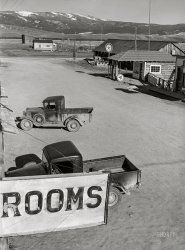
- Wheat Whacker: 1941
- August 1941. Froid, Montana. "Scandinavian tractor combine driver drinking water out of a jug in ... their earlier wheat crop before coming up here for the Montana harvest season." Medium format acetate negative by Marion Post Wolcott ... Posted by Dave - 07/28/2021 - 3:19pm -
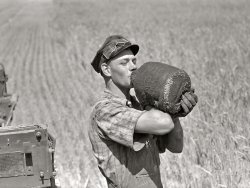
- The Lady in Purple: 1952
- ... Dave]
If it IS her, she was born January 11, 1908 in Montana to a Charles and Mildred (Teeter) Gamble. According to the 1910 Census, she lived in School District 17 of Valley County, Montana. At some point after 1920 she moved to Fairmont, Minnesota. In 1929 ... Posted by Dave - 08/11/2014 - 5:24am -
![The Lady in Purple: 1952 "Kay Fancher -- 23 Feb 1952." The latest episode of Minnesota Kodachromes co-stars Hubert's record collection, which includes the classics Accordiana and Larry Adler: Harmonica Virtuoso. Also: antimacassars protected by antimacassars! 35mm color slide by Hubert Tuttle. View full size.
That Ashtray, part 2Push that small button and all those nasty cigs and ashes disappear, like magic. Just don't make an 'ash' of yourself and keep pushing it to hear the neat noise it makes.
[The only places I had a chance to do that were in department stores and bus depots. -tterrace]
That ashtrayYou could practically eat off that thing! I suspect someone was extraordinarily fastidious with their housecleaning.
The golden age of smokingI count three ashtrays, or maybe five if that's a stack in the middle. And see how shiny the metal one is. With matches at the ready!
[Below is an alternate view. Click to enlarge. - Dave]
Dem ShoesQuite a nice record collection here, but I noticed the same thing as Sagitta and davidk. What a housekeeper! And ashtrays are so rare today, if you have one sitting in your house, guests look at you as if you are about to expose yourself. Best of all, I LOVE those shoes!
The MatchbookThis one I believe.
Kathryn Charlotte (Gamble) Fancher (Rogers)I suspect our Kate could be Kathryn Fancher, of nearby Fairmont, Minnesota, as she's the only Kate/Kathryn/Catherine/et al Fancher living in the area at the time.
[Name note: It's Kay, not Kate. - Dave]
If it IS her, she was born January 11, 1908 in Montana to a Charles and Mildred (Teeter) Gamble. According to the 1910 Census, she lived in School District 17 of Valley County, Montana. At some point after 1920 she moved to Fairmont, Minnesota. In 1929 she wed a Roger Fancher, and they had two children, Joseph Charles (1936) and Barbara Ann (1938). At some point before 1960 she and Roger separated (he married again in 1960), and Kathryn kept her ex-husband's name until she married Lloyd Rogers in May of 1993 at the age of 85. Lloyd died the following March. Kate died away in Fairmont June 21, 1996 at the age of 88.
She seemed to have lived in Fairmont, Minnesota, for all of her adult life.
Correction: Mildred would be an older sister, the mother was a Jessie Teeter. Strangely, in 1920 Jessie is listed as Head of House and her husband as secondary - that's what threw me for a moment. I've never seen the wife declared head on a census form before with the husband still living, so it surprised me.
Maybe They Were CommonWe have a vase identical to the ones on the table to her left. It still looks just like it did in 1952.
ShoppingI really want her suit and shoes.
I forgot those ashtrays existed. Ours was blue, I think and I do not recall that tray around it. This one must be the higher end version.
(Minnesota Kodachromes)](https://www.shorpy.com/files/images/SHORPY-MNK287A.thumbnail.jpg)
- Mildred's Place: 1938
- ... a magnificent sense of humor." Somewhere near Big Hole, Montana, Vachon made friends with a sheep rancher, who took him deep into the ... Posted by Dave - 08/02/2017 - 11:42am -
![Mildred's Place: 1938 October 1938 at the Alamo. "Mildred Irwin, saloon singer at North Platte, Nebraska. She entertained for 20 years in Omaha before coming to North Platte." Medium-format safety negative by John Vachon. View full size.
Letter from John Vachon to his wife, Penny:
October 29, 1938
Last night I had an adventure. Of the 1st water. To have it I had to get kind of stiff. And I did, dear. Pretty plastered. But it was all in the line of duty, eminently legitimate and justifiable. About eight o'clock I went into a corner saloon. It was a saloon in the grand tradition. I drank only beer, but great gobs of it. At the piano was a big huge large fat blonde woman of 45 to 50 yrs. With beautiful smeary red makeup on her puss, and huge mammy type bosoms. And her voice, O that you could hear her voice. She has Sophie Tucker in the wastebasket . . .
Hah!The boys at the bar look like they're rethinking the idea of moving to North Platte!
Mildred IrwinApparently she was a popular entertainer in her day. You can buy her CD (or just listen to her bang out "Little Rock" on the piano) here: http://www.croscrane.com/mildred.htm
John on MildredMr. Vachon may have had photog skills, but he's not too bad with a pen, either. Pretty colorful descriptions. The phrase...1st water...which I've heard only occasionally, seems used in the same sense as 'of the first order'. But 1st water also makes me think that it refers to bath water which in earlier times was a shared commodity. Handed down, so to speak. And first water would be, obviously, the first and best. We kids had to share bath water a lot back in the 50's, that part I do know.
I'll definitely have a listen to the link. Now to figure out what he meant by Sophie Tucker in the wastebasket.
[He means Mildred is the better singer. She puts Sophie to shame. - Dave]
Piano tuner neededI listened to the clip on the web site posted by Mattie. Either that piano was badly in need of tuning or Mildred Irwin preferred to use some bizarre non-Western scale.
First WaterThe phrase "Of the first water" comes from gemology.
Mildred's Audio ClipThat's the music I hear in my head when I think of "honky-tonk." That was great!!
Did you see the disclaimer?Here's the disclaimer on that site:
DISCLAIMER The music on this compact disk is a studio re-creation. It is not an actual recording. We do not wish to mislead anyone into believing that Mildred Irwin -- a real entertainer who played the piano at the Alamo Bar, a real bar in North Platte, Nebraska -- actually played the music you hear on this disk. She did not. As described in Charles M. Von Rosa's notes included in the booklet inside, this music was re-created using the limited information available. Like the bulk of the music heard on the radio these days, this music is fake. However, as our purpose is to honor a long neglected fabulous entertainer, here it is. We sincerely hope you enjoy this recording as much as we enjoyed putting it together. - Croscrane™
Audio ClipActually, if you read the fine print on that site, it basically says that audio file has nothing really to do with Mildred except being inspired by her. It's a modern recording intended to sound old---and to my ears it sounds much like a midi file, which they didn't even have in the '30s. Kind of a questionable tribute to the lady, really...
Not a vintage recordingDid anyone read the disclaimer towards the bottom of the page Mattie linked to? It says it's a studio re-creation of Mildred's playing...doesn't say when it was re-created...could've been a year ago.
Mildred (Not)I missed the disclaimer. I bet Mildred wouldn't be happy with that. Too bad there are no actual recordings of her playing.
Pat AstMildred is the spitting image of Pat Ast.
Mildred IrwinI live in North Platte and do alot of local historical research. I've seen all the pictures of Mildred that John took through the Library of Congress website. My question is what happened to Mildred after she left North Platte? I can't seem to find any references to her anywhere.
Just curious.
Mildred is mentioned here"It was John Vachon, however, who met the most audacious array of non-conformists, and he quickly fell under their spell. He eagerly photographed one old man who lived in the town dump and who "displayed a magnificent sense of humor." Somewhere near Big Hole, Montana, Vachon made friends with a sheep rancher, who took him deep into the range country, cooked him a meal in the open, and gave him his first horseback ride. (This fellow was hardly the defeated victim that Nathan Ache's sheep herder had been.) Although Vachon felt the rancher was an 'individualistic type which has probably outlived its usefulness,' Vachon still thought this character was the salt of the earth and an irresistible subject. But it was in North Platte, Nebraska, that Vachon found his greatest infatuation. At a local bar he discovered Mildred Irwin, "a big fat blond woman of 45 or so, with a beautiful red smary paint job." She had been an Omaha prostitute for nearly twenty years and had then retired to North Platte to play honky-tonk piano in the bar and sing "like Sophie Tucker--only very nasty songs." Completely smitten with this woman, Vachon took picture after picture of her, and "made 3 trips back to the hotel for more flash bulbs." By the late 1930s and early 1940s, documentary photographers were increasingly on the lookout for the likes of Mildred Irwin and searched less and less for subjects like Lange's "Migrant Mother". As conditions slowly improved and the crisis receded, it seemed less important to promote social legislation or confront the "realities" of the decade, and documentary photographers gradually turned to savoring the eccentricities of the people they met."
from Hope Among Us Yet: Social Criticism and Social Solace in Depression America
By David P. Peeler
University of Georgia Press, pp 105-106
(The Gallery, Eateries & Bars, John Vachon, Music, Omaha)](https://www.shorpy.com/files/images/SHORPY-8b14115a.thumbnail.jpg)
- Baby Barkhoefer: 1942
- April 1942. "Hamilton, Montana. Ted Barkhoefer and family." Medium format acetate negative by John ... wife that he had taken at least 70 pictures in Hamilton, Montana. But he admitted that Jack Delano would have shot many more.
(The ... Posted by Dave - 10/22/2021 - 12:37pm -
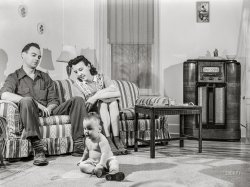
- Ninety-Nine: 1943
- ... is WWI, or possibly Spanish-American. The hat has the Montana peak, which was standardized after the Spanish-American War to prevent ... Posted by Dave - 01/31/2009 - 5:02pm -
![Ninety-Nine: 1943 January 1943. Trampas, New Mexico. "Grandfather Romero, a member of the family of Juan Lopez, the majordomo, is ninety-nine years old." Medium-format nitrate negative by John Collier, Farm Security Administration. View full size.
Personal ShrineIt appears that Sr. Romero or a family member assembled his favorite photos on and around the wall bracket decorated with a cut-magazine paper valance. The photo at top center of a young man in uniform looks quite like him, except that it appears to date from the Spanish American War, and he would have been 54 in 1898. Perhaps it is his son. That photo covers the glass face of an 1870s bracket clock, which is thereby converted to a fancy picture frame for the portrait that has the place of honor in the group.
Recycled Clock GlassOn closer inspection, the glass from the bracket clock was removed and cut down to protect the family album photos in the small frame hanging beneath the clock bracket. The gilded lines on the clock glass overlay most of the photos in the frame, except the postcard photo at left of a cowboy on horseback tending cattle, which is tucked into the frame over the glass.
The Clock, Cont'dIf you look closely at the photo in the clock, you can see the decorative scrollwork that would have framed the clock face and run down into the pendulum area. Perhaps a different clock glass was used for the photo frame beneath the shelf.
[I think you're right. - Dave]
Ansonia clockLooks like an Ansonia of New York clock. We have one hanging in our kitchen that has almost the same scrollwork and glass decoration. It was a wedding gift to my husband's grandparents around 1914 in Cuba.
http://www.antiqueansoniaclocks.com/Ansonia-Clock-Model-Names.php
TonicWhat's the box in front of the clock? Looks like a patent medicine carton.
Clock bits!That frame under the clock with photos is the whole door of an old kitchen clock! The hinges look like they're still on it, and the glass is in it too!
That top clock is closer to 1890 from the looks of it.
Shelf PaperIt appears to be a newspaper page that someone has folded and cut to make a sort of decorative border. Almost looks like a paper doily.
[They're pages from a magazine that look like they've been trimmed with pinking shears. Color ads for Mohawk carpets (on the left) and a mattress ad with busty babe. - Dave]
ContrastsThe bare room, the torn newspaper (probably reminding the gentleman of past adventures), that gorgeous pillow cover. Together they tell a story of the art of living and of loving what you have. Wonderful composition.
[That's no torn newspaper. It's some pre-Martha Stewart craftiness. - Dave]
Another military manAmong the photos in the recycled kitchen clock door turned picture frame is one of a young man also in US military uniform. He posing in front of the US flag. The photo appears to be circa WWII.
Of Clock Glasses, etc.I'm still going with the glass in the picture frame having come from the clock. Its ornament is typical for Ansonia and Waterbury mantel clocks of the 1870s. And, although the scrollwork behind the soldier does resemble the sort of gilded linework that one might see on a clock glass, the photograph is opaque, and does not allow one to see anything of the clock face or pendulum behind it, and there is definitely no glass in front of the photo as seen.
[Three things I will note from the detail below. First, the painted design is obviously not part of the photo of the soldier. Second, it fits exactly over the clock face. Third, the glass down below wouldn't fit the clock, as you can see where I've superimposed it. - Dave]
Beautiful Photograph !That is beautifully composed picture......wonderful art.
Good job, Dave!The additional enlargement of the soldier enabled me to see that the scrollwork on the glass does indeed extend down over his body, which I had not been able to discern before, and that the photo must be behind the glass of the clock after all. My bad, and so much for my wicker chair theory, but they do turn up in such photos regularly. Do you ever get the feeling that you're sitting in a lifeguard's chair by the side of the plunge, wondering when the next confused soul is going to get in too deep and need rescuing? Thanks for your patience and good humor.
Religious homeTo the left below the picture of the Sacred Heart of Jesus is a crucifix with a skull and crossbones. You don't see this very much except on very old crucifixes. From the Catholic Bulletin comes this explanation for the skull and crossbones:
Pious legend held that Adam was buried at Mount Calvary and so the skull-and-crossbones symbolizes Adam. The skull-and-crossbones also symbolizes death and so putting one at the base of a crucifix symbolizes Christ's triumph over death through death.
To the right over the bed is a picture of Santo Niño de Atocha.
Growing up as children in El Paso Texas we usually had a crucifix, picture or statue of our patron saint above our beds to watch over us as we slept.
The rosary around the frame is at arm's length from the bed where Mr Romero probably prayed just before he went to sleep. My familiarity with the way the photos are arranged in this cluster was generally to pay homage to people that had died. Other photos would usually be elsewhere on display in other parts of the room. I might assume that the man in the frame was a relative that was killed in war. There is a sense of humble modesty in older generations that keep them from putting pictures of themselves in such a prominent place.
I'm 44 but I recall when I was a kid that a particular aunt of mine would keep a picture of my uncle (her brother who was killed in WWII) in a frame along with small pictures of Our lady of Guadalupe, Santo Niño, several relatives that had passed, funeral cards, , palm fronds, from Palm Sunday, folded into small crosses, a candle and, yes, a picture of John F Kennedy. This is also where she kept her rosary.
The soldier isn't WWIIIt is hard to make out exactly, but that soldier is WWI, or possibly Spanish-American. The hat has the Montana peak, which was standardized after the Spanish-American War to prevent water from pooling atop the hat.
[You're looking at the wrong photo. - Dave]
100?Did he make it to 100? Inquiring minds still want to know.
(The Gallery, John Collier, Portraits)](https://www.shorpy.com/files/images/8d25843u.thumbnail.jpg)
- Star Garage: 1942
- April 1942. "Missoula, Montana. Garage." More curbside gas pumps! Medium format acetate negative by ... Posted by Dave - 02/18/2022 - 12:43am -
![Star Garage: 1942 April 1942. "Missoula, Montana. Garage." More curbside gas pumps! Medium format acetate negative by John Vachon for the Farm Security Administration. View full size.
Concrete MixerMade by Jaeger in the foreground. These were powered by stationary hit and miss engines. I have the engine sans mixer in a 3.5 horse size. The one that would be in this one was likely smaller. More like a 1.5, or 2.5 engine. Jaeger bought their engines from Hercules, which were made in Evansville, In.
Still there, kind ofI found the building today, but not as I expected to. On the wall of a downtown gym, forever memorialized in paint.
SolidThat's a honey of a building with a lot of impressive decorative brickwork. I'm loving the fleur de lis blooming on either side of the main title. The arches are divine.
IncognitoThis article says the nondescript building at 149 W. Front has been many things: Star Garage, restaurant, Star Garage Disco, and offices. It lost its second story (why?!?) in a 1970 remuddle, when it was converted from garage to restaurant, and then lost all but one arch when it was converted to offices.
BrutalUsually I favor saving and restoring old buildings. In the case of what they have done with the Star Garage there in Missoula?
Not so much.
Again?Pearls of wisdom almost every photo. Isn't anyone else commenting? Really Dave.
[Well, there's you, and all these other people. - Dave]
PrescienceAn early WWW.
(The Gallery, Gas Stations, John Vachon, Small Towns)](https://www.shorpy.com/files/images/SHORPY-8c22011a.thumbnail.jpg)
- Pony Mart: 1939
- June 1939. "General store in Pony, Montana." Back when the brands on stallions, bulls and heifers migrated to the ... gas at 25 cents a gallon. The current cost of gas in Montana, at roughly $2.50, converted to 1939 dollars, is 14 cents. Factor in ... Posted by Dave - 12/08/2017 - 11:19am -
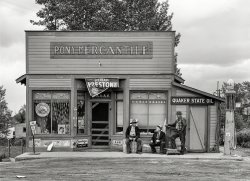
- Beauty Ress Court: 1942
- April 1942. "Missoula, Montana. Entering the town. Tourist apartments." More specifically, the ... Posted by Dave - 02/12/2022 - 8:14pm -
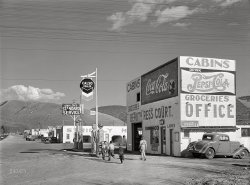
- The Squeaky Wheel: 1904
- ... a machinist in the Northern Pacific shops in Livingston, Montana from the 1930s through 1950s. I barely remember the steam locomotives, ... Posted by Dave - 08/21/2012 - 5:54pm -
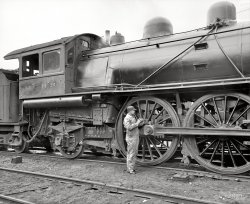
- Dude Girl: 1941
- ... girl with two cowboys at a Saturday night dance in Birney, Montana." Medium format acetate negative by Marion Post Wolcott. View full ... English journalist Alistair Cooke was driving through Montana on the cross-country journey that would eventually become the subject ... Posted by Dave - 10/12/2019 - 6:51pm -
![Dude Girl: 1941 August 1941. "Dude girl with two cowboys at a Saturday night dance in Birney, Montana." Medium format acetate negative by Marion Post Wolcott. View full size.
What a smile!I wonder what happened to that pretty girl with the pretty smile, and if she ended up married to a Cowboy.
Like Cooke's CookieThe next year, young English journalist Alistair Cooke was driving through Montana on the cross-country journey that would eventually become the subject of his book "The American Home Front, 1941-1942." In describing his journey through this part of the state, he wrote, "in the first year of the American war, and at harvest time thereafter, across many different landscapes, the American woman became a peasant - a peasant I noticed elsewhere with a tan and a high hairdo, and often with scarlet nails, ready for an evening of jitterbugging with the resident soldiery."
Dude looks like a ladyWow! To use the parlance of those days, what a tomato!
However, if she were my daughter I sure wouldn´t like the way that fellow toking on the smoke is looking at her.
Romance on the horizonBe careful. I think the guy on your right is the man your mother warned you about.
Dude ranches were the rage as noted by the number of movies featuring singing cowboys and wives waiting to undo the knot. Birney seems an unlikely choice. Located 65 miles East of Crow Agency, Birney and the Quarter Circle U (according to Rand McNally directions), is reached by a series of unnamed and partially unpaved roads.
Here is Birney in its heyday with additional photos (from the same photo shoot) and a good write-up of the problems that forced many of them out of business.
http://www.wyomingtalesandtrails.com/birney.html
AMATEUR NIGHT OUT - All dressed upThese young fellows seem to be awkwardly concentrating on looking "manly," studiously handling their Lucky Strikes to impress the gal who has been more likely charmed by one of our favorite photographers. The fellow on the right has probably just had a fine haircut for the occasion with the other seeming to be sporting a hairpiece?
Where is the SMOKING MANDITORY sign?
[Next to the SPELLCHECK MANDATORY sign. - Dave]
(The Gallery, M.P. Wolcott, Pretty Girls)](https://www.shorpy.com/files/images/SHORPY-8c15742a.thumbnail.jpg)
- F Battery: 1918
- ... in a manner discontinued in 1911 when the Army adopted the Montana Peak look. The leggings look pre-WWI. See the illustration of 1906 ... Posted by Dave - 12/04/2014 - 2:35am -
![F Battery: 1918 "Lithnan & Latham, F Baltcry. 12 Peduri [?]" is the Library of Congress's uncertain transcription of the handwriting on this circa WWI negative. Which seems to say "F Battery," not Baltcry. "Lithnan" and "12 Peduri" are also iffy. Who can help us sort it out? National Photo Company Collection glass negative. View full size.
Bear and LadyA performing bear (see the chain?) is being led by his itinerant showman-master (see the pack?) past a young woman who has tried to climb a stile or fence in fright, and in the process has her skirt caught, exposing what shouldn't be exposed.
Somewhere there is undoubtedly a caption with a double-entendre in it.
Barracks ArtI'd be interested in getting a better look at the pictures on the wall behind these guys. The one at top center looks like a woman with some exposed decolletage. Nothing too racy today, but basically the same subject matter that you would still see in a barracks today.
[Click the image to enlarge, then click a second time to expand. - Dave]
Could it beCould that be John Latham?
http://www.history.army.mil/html/moh/worldwari.html
http://www.medalofhonor.com/JohnLatham.htm
9:25I love close-ups. We have (from left to right):
- the time (9:25 - presumably in the morning)
- baseball cards
- WWI photos
- presumably family photos
- a group photo (likely the company from WWI)
- more baseball cards
- photos of various buildings
- and yes, more baseball cards
PosterAbout the poster on the lower left side of the bulletin board, on closer examination it appears that a bear has the lady stump trained and is lifting up her dress.
Baseball cardsThey all look like tobacco cards. The top right card is of Jean Dubuc, from 1914. Others are from 1909-11.
Baseball cardsNever mind the cheesecake...look at all those baseball cards! Wish I had them on my wall.
War Camp CanteenReminds me a little of this one. Except there's no drooling. Or maybe this one, with the pool table and Victrola.
12 PeduriLooks like "12 Picture(s)"? LOVE this site simply outstanding.
More Baseball Cards
This photo: http://hdl.loc.gov/loc.pnp/npcc.30803 [Entitled "Young man in dormitory room"] from the same collection has similar material hanging on the wall. Could it be the same barracks?
[This looks like a dorm room at a military school or service academy. And strikes me as more boudoir than barracks. There are tens of thousands of negatives in the National Photo collection. Two pictures with baseball cards doesn't mean they were taken at the same place. It's a neat photo regardless. - Dave]
Arlie LathamThe numerous baseball mementos suggest the possibility of an alternate Latham: Arlie Latham, a famed baseball player, served as umpire to Army-Navy baseball matches in the 1910s.
Incidentally, I can see the "12 Pictures" but not so sure about "Lithnan" as first name. How about "Littrinan"?
With my little eye I spyHere's what I think about this photo:
This is the barracks day room of Battery F or an unknown horse-drawn Field Artillery Regiment. I think this is prior to 1918.
The soldier in uniform has a belt buckle that looks like a snaffle bit and his hat is creased in a manner discontinued in 1911 when the Army adopted the Montana Peak look. The leggings look pre-WWI. See the illustration of 1906 uniform at
http://www.militarymuseum.org/Resources/thanks.jpg
Also in this illustration is an example of the the cap seen above the alarm clock.
The large drawing on the wall is for a field gun...75mm? To the left of the drawing is a tanatlizing order or memo, with signatures, and most likely a headquarters designation. Any chance of a closer look at these two, Dave?
Among the picture collection is a photo of a mounted unit in the field.
Gas light fixture above the pool table has been refitted for electricity.
The girlie photos all have a gay-90s look, not at all WW1 era. The picture at the top has an imprint top left...photographer? If the baseball cards are all from the 1910-11 timeframe then I think I am on the right track.
Knew What They LikedThey might not have known much about art, but they didn't seem to be too single-minded. A variety of subjects, not just the cheesecake one might expect. But the one on the left with the bear is certainly the strangest/kinkiest.
(The Gallery, Natl Photo, WWI)](https://www.shorpy.com/files/images/31074u.thumbnail.jpg)
- The Singing Cowboys: 1939
- June 1939. Big Horn County, Montana. "Cowhands singing after day's work. Quarter Circle U Ranch roundup." ... article with more photos and history of this and other Montana ranches.
(The Gallery, Arthur Rothstein, Camping, Frontier Life) ... Posted by Dave - 04/09/2018 - 11:24am -
![The Singing Cowboys: 1939 June 1939. Big Horn County, Montana. "Cowhands singing after day's work. Quarter Circle U Ranch roundup." Medium format acetate negative by Arthur Rothstein for the Farm Security Administration. View full size.
Somebody tell methat's not Gary Cooper in the center.
Well thenThat means that Harry Carey is sitting just to his left. Maybe it's a Ford Production.
[Harry Carey Jr., maybe. -tterrace]
Indeed, my error!
Clever flash placementIt even appears to be further concealed with propped-up firewood. And I bet everyone but the harmonica player was vision impaired for the rest of the evening!
And on guitarWalter Cronkite.
[I see Preston Foster. -tterrace]
Preston on tenorThat's an interesting guitar that Preston Cronkite is playing. It's a 12-fretter (the body join is at that fret rather than the 14th fret that is more often seen nowadays) tenor guitar. Doesn't look like a Martin to me, as the soundhole rosette is fancier than the top binding would dictate. Maybe a Harmony. No pickguard.
I've owned a couple of old tenor guitars and never could decide how to tune the darned things. His is likely tuned as a regular guitar (EADG strings only), as he seems to be fingering a G chord. Most players tuned them like a tenor banjo (CGDA), I believe.
The fellow on the left may be playing harp, so let's call him Harpo.
SuddenlyI want a Marlboro.
Quarter Circle UNice article with more photos and history of this and other Montana ranches.
(The Gallery, Arthur Rothstein, Camping, Frontier Life)](https://www.shorpy.com/files/images/SHORPY-8b18183a.thumbnail.jpg)
- The Pop Shop: 1941
- ... far more prosaic.
So much soda, so many debates In Montana in the 1950s, it was Nesbitt's orange, Hires root beer, and definitely ... Posted by Dave - 10/28/2012 - 2:15pm -
![The Pop Shop: 1941 October 1941. New Baltimore on the Hudson, New York. "Store on the Hudson." Held together by pop signs. My favorite is the one for Nehi -- nothing goes with grape soda like a sexy pair of gams! Photo by John Collier. View full size.
It's still standingMinus all the signs but still there. The electrical conduit is still attached to its neighbor after all these years but no longer connected.
[It's definitely in the same place. - Dave]
The enclosed front area seems to have been added since the picture was taken, the original structure was a straight drop from the roof to the ground, this would also explain where the windows went.
[It's a different structure. The old one abutted the building next door; as mentioned in the comment above, you can see the ghost of its roof line - which is different than that of the present building - on the brick wall. - tterrace]
You're right! I hadn't noticed that detail.
It must have been done a long time ago since the new structure looks rather old itself.
Perhaps the original fell down when they pulled out the nails to remove the signs.
ThirstyNow I am craving a grape Nehi! Best cold drink in the world to me as a little girl. Orange. Ame in second. Good memories.
NehiI finally "got" the sign. Who can explain it?
Dem bonesYou can see in the modern photo a ghost of the old roofline. Not much more than the bones left of the original structure, if that.
Nehi againOrange was the flavor to kill for.
Pop PunNehi is knee-high, obviously, though it never would have occurred to me, the logo having disappeared as far as I can remember. There would be so many other choices, but it was a modest time.
Knee HighI'm impressed with you folks! I could have puzzled over that sign for months without catching onto that visual pun. I guess the Hire's "It Tastes So Good" slogan is more my speed!
Let's go to the tapeCoke 5, Pepsi 1.
Only in a Wide Open TownI have monitored the Shorpy photos of "mom and pop corner stores" for years hoping to see a Nehi sign with "THE LEG". Leave it to New York to permit such a racy sign. Most of the southern state Nehi distributors probably chose to offer a toned down sign with just Nehi or Nehi and a bottle. The movie "A Christmas Story" was based upon several short stories by Jean Shepard which included the one where Ralphie's dad won a major prize (the Leg Lamp) in a drawn out puzzle contest. My wife and I are the proud owners of an antique Nehi store cooler with THE LEG which bears an uncanny resemblance to the Leg Lamp in the movie.
Nehi GrapeSpent 3rd thru 8th grades in North Carolina in the mid-50s, and Nehi Grape was simply IT: the best flavor this kid can remember.
BeautifulEven in its deplorable 1941 condition this building has its own appeal, especially in the bay windows and very handsome roof gable design, both obviously made long ago with a sensitive eye for details. Though functional, its replacement lacks a soul.
Grape NehiGrape Nehi was of course the favourite beverage of Corporal Walter "Radar" O'Reilly on the TV series M*A*S*H. For those of us who grew up in Canada or other areas where the product wasn't sold and indeed was not virtually but totally unknown, this beverage sounded extremely exotic, perhaps something from an obscure company in rural Kansas or something. The truth it seems is far more prosaic.
So much soda, so many debatesIn Montana in the 1950s, it was Nesbitt's orange, Hires root beer, and definitely grape NEHI. Probably a regional thing. I think NEHI also had a killer cream soda and a strawberry soda as well.
(The Gallery, John Collier, Stores & Markets)](https://www.shorpy.com/files/images/SHORPY_8c33529a.thumbnail.jpg)
- Froid Depot: 1941
- August 1941. "Railroad station in Froid, Montana." Medium format acetate negative by Marion Post Wolcott for the Farm ... Obvious I am told he got his start as head of the Montana State Board of Municipal Names.
(The Gallery, Kids, M.P. Wolcott, ... Posted by Dave - 09/08/2019 - 12:12pm -
